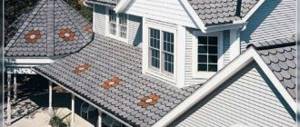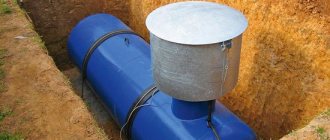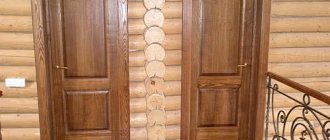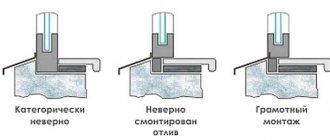As an alternative to traditional vegetable storage built from brick or concrete, you can consider a plastic cellar, which has many advantages.
A plastic cellar is presented in the form of a small box, which is equipped with stiffening ribs (they may not be present), a sealed lid, a ladder, and shelving. The size of the cellar can vary significantly depending on the wishes of the owner and the possibilities of installation on a particular site.
Advantages of plastic storage
Plastic structures for summer cottages have a lot of advantages, so reviews about them are mostly positive. If you have the financial means, you can purchase a more technologically advanced fiberglass version.
Fiberglass cellar.
The main advantages of such storage are as follows:
- The cellar can be placed on any site, regardless of the groundwater level, soil type and other factors that usually prevent the construction of traditional storage facilities.
- Most of the work typical for constructing a traditional cellar is simply discarded, because we have a ready-made building for food storage, which does not require additional finishing.
- Installation can be done not only in an open area, but also under any building (garage, house, barn, etc.). Of course, if the structure has already been built, then the installation will be somewhat complicated by additional excavation work.
- A plastic or fiberglass one-piece cellar can easily withstand temperature changes and high humidity. If the storage facility is properly installed and equipped with an effective ventilation system, the quality of food storage in it will be much higher than in a traditional basement.
- The walls of the cellar are reliably protected from biological influence, so insects and rodents will never get to your vegetables. The plastic used for the housing will not absorb odors emanating from stored products. It is completely inert to moisture and is easy to clean and disinfect if necessary.
- Manufacturers note that plastic structures can last at least 50 years under any operating conditions.
Characteristics of popular models
When planning to purchase a plastic caisson for a cellar, you need to decide on the size of the structure. The main factors that influence the dimensions of the plastic caisson include:
- Availability of free space in the environment - if the caisson is installed in a free place, then its dimensions have no restrictions, and if it is planned to be placed as a country house or garage, then the architecture of the upper building must be taken into account.
- Estimated storage volumes - if you are going to store 2-3 bags of potatoes and several dozen jars of preparations in the cellar, then you can get by with the minimum dimensions of 1.2 x 1.2 x 1.75 meters. In the case when more vegetables and seams are planned, then the dimensions of the structure should be increased.
- The price that the owner agrees to pay - the cost of a minimum size plastic structure starts from 50-60 thousand rubles, installation adds another 30-60%. Based on these figures, it is fair to assume that the price for a medium-sized plastic cellar with installation will be 200–300 thousand rubles.
The installation location and size of your plastic basement will also affect the design of the entrance. The following options are available:
- Classic - you can get into the cellar through a hatch in the upper part of the structure.
- Lateral with partial recessing - the entrance to the caisson occurs along a gentle staircase through a horizontal hatch or an inclined door.
- The side one is traditional - a gentle staircase leads inside, starting with a vertical door.
Triton
The company specializes in the production of polyethylene cellars. One of the options is ribbed rectangular hulls for the caisson structure:
- Model name: Triton 2.5.
- Price: 72,000 rubles (+ installation 32,300 rubles).
- Characteristics: 1.2x1.2x1.75 m, volume 2.5 cubic meters, entrance through the top hatch, three rows of shelves.
- Pros: ease of installation.
- Cons: none found.
As an alternative to rectangular cellar structures, the company also produces cylindrical plastic caissons. They are convenient from an ergonomic point of view, making the most efficient use of the occupied space:
- Model name: Triton 6.3.
- Price: 120,000 rubles (+ installation 53,500 rubles).
- Characteristics: 2x2.3 m, volume 6.3 cubic meters, three rows of shelves;
- Pros: The cylindrical design is compact and suitable for situations where space is limited.
- Cons: the location of the hatch in the center implies a certain installation of the entire structure.
Tingard
The company positions its products as “unique seamless ready-made cellars made of plastic” - this ensures high reliability for the caissons. All models of this company have a top entrance (with a hatch 80x70 cm), differing from each other only in size:
- Model name: Tingard 1500.
- Price: 99,800 rubles (excluding installation).
- Characteristics: 1.5x1.5x1.9 m, volume 4.3 cubic meters, metal ladder, wooden shelves and flooring, weather station.
- Pros: the manufacturer specifies a service life of 100 years.
- Cons: an entrance with a top hatch in the design will not be convenient for everyone.
- How to determine a person's location by phone number online
- Homemade cottage cheese - delicious recipes and step-by-step preparation. How to make homemade cottage cheese, video and photos
- Applesauce for the winter
Ready-made cellars made of plastic from the Tingard company, for the production of which rotational molding from food-grade polyethylene is used, are distinguished not only by high quality and long service life, but also by 100% tightness. In a cellar of this design it is always dry, and the temperature in winter is at 3-8 degrees:
- Model name: Tingard 2500.
- Price: 179,000 rubles (excluding installation).
- Specifications: 2.4x1.9x2.1m, volume 9.6 sq. m.
- Pros: large sizes.
- Cons: similar to the previous model.
Titanium
The model range of this manufacturer includes many options for caissons of different sizes, up to 30 square meters. m. The buyer only has to choose the entrance option and suitable design parameters:
- Model name: Titan-Agronom.
- Price: 186,900 rubles (+ installation 75,000 rubles).
- Characteristics: 2x2x2 m, volume - 8 cubic meters, upper shallow entrance, hatch 80x175 cm.
- Pros: reinforcement of the cellar bottom, humidity and temperature indicator.
- Cons: additional space is required to install a flat staircase.
By purchasing a plastic cellar, the buyer receives not only a polypropylene frame, but also a ready-made internal layout. There are stairs, plastic shelves, exhaust pipes, and other necessary infrastructure:
- Model name: Titan-Gardener.
- Price: 236,000 rubles (+ installation 85,000 rubles).
- Characteristics: 3x2x2 m, volume - 12 cubic meters, entrance door 80x180 cm, has a lock.
- Pros: bonus from the manufacturer in the form of free installation of lighting and additional insulation of the neck.
- Cons: none found.
Flaws
Of course, a plastic cellar also has its disadvantages, which force many people to refuse to install such a storage facility on their site, choosing a regular basement for storing food.
- Plastic cellars are quite expensive. When compared with conventional storage, the plastic version will cost 40-50% more (and this is only the cost of one case). In addition, you will also need to install and equip it.
- A turnkey cellar, as a rule, has standard sizes, so this is often very inconvenient if a country homeowner, for example, has already prepared a pit for arranging a vegetable storage.
The main disadvantage is the high cost. But it is more than compensated by trouble-free operation over a long period of time.
Plastic cellar with side entrance
Over time, the plastic cellar began to change its design, because... In addition to practicality, convenience and ergonomics were required. It’s just that the classic cellar was no longer quite suitable; there was a demand on the market for plastic cellars with a side entrance. And it immediately responded to demand, and for the first time in Russia it released a line of such cellars under the TITAN .
The TITAN line of cellars includes cellars for any operating conditions and landscape features of the site. There is a cellar with a gentle slope, which partially conceals the area of the cellar, and the entrance group partially extends beyond the dimensions; this is the most popular cellar (after the “Classic”) “Agronomist”. If you need a cellar whose entrance completely extends beyond the dimensions, then there is such a cellar in the line, called “Farmer”.
In the line of TITAN cellars there are also cellars with partial deepening, such as the “Gardener” cellar, which is mounted into a hill or mountain range, and “Dachnik” is buried only 1700 mm, and a bulk hill is formed on top.
What to look for when purchasing?
When choosing a ready-made storage facility, you need to pay attention to the fact that its body is made of high-quality and environmentally friendly materials. In a store or market, you can ask sellers for all documents and certificates to ensure that the product is safe to use. In particular, you need to be responsible because a plastic factory cellar is quite expensive.
Almost all selling companies also deliver and install their products.
The installation of a finished cellar for a summer cottage should be carried out by specialists who will not only help with choosing the most suitable location, but also help with arranging the interior. In addition, before installation, they will assess the groundwater level in the area, making a reliable foundation.
When purchasing a case, be sure to ask the seller if their company provides installation. Because the specialists of this company are familiar with the features of the product and have certain experience, which will allow them to correctly install a plastic cellar in a short time. Of course, you can do the interior arrangement of the cellar for your dacha yourself. If the finished cellar is installed in a basement, then the lid for it can be made of wood.
As a rule, all plastic storage facilities are immediately equipped with a ventilation system, which consists of several holes and pipes. Such ventilation is standard, so it often needs to be modified to take into account specific operating nuances. For example, if a large amount of food is to be stored in the cellar, then a forced ventilation device will be required, because the moisture released by vegetables and fruits will necessarily fall out in the form of condensation, which must be disposed of immediately.
The storage size also plays a significant role. A plastic cellar (like any other) can be made individually, but it will cost more.
How to buy a cellar at a low price?
When choosing a plastic cellar from various manufacturers, you will undoubtedly encounter a dilemma about which cellar is better to buy and how they differ. For a non-professional, choosing the right product is a serious problem that we will help you sort out. First, you need to decide what shape and size cellar you need to buy. After deciding on the design features of the plastic bin, it remains to decide on the manufacturer. And here the most important thing is not to make a mistake, since once you buy a plastic cellar, it will serve you for at least a hundred years.
Particular attention should be paid to the manufacturer, or more precisely, how many years he has been on the market, where his production is and whether it is possible to drive there to see the production process live. If for some reason you are not allowed into production, we recommend that you immediately cross out such sellers, thereby limiting yourself from scammers. The next thing you should pay attention to is the material from which the plastic cellar is made. The low price directly depends on the quality of the plastic from which the caisson is welded. It must be made ONLY from food grade polypropylene. As a rule, it is food-grade plastic that is produced by foreign companies, since some other manufacturers partially add recycled materials to reduce the cost of products, which negatively affects the ecology of the product. All sellers will assure you that they have a plastic cellar, you will buy it from food-grade polypropylene, but words are words, and the quality must be confirmed by a certificate.
Therefore, we recommend that you buy a plastic cellar from the manufacturing company Expocom LLC, which produces products under the TITAN brand. This manufacturer is the founder of the production of TITAN plastic cellars in Russia. In the manufacture of products, we use only food-grade polypropylene from a Czech company, which is confirmed by international certificates. TITAN has a fair price for a food, ECO cellar. And remember: QUALITY HAS NO ANALOGUES!!!
How to install?
Installation generally takes place in several successive steps:
- Digging a pit of a suitable size.
- Concreting the bottom or installing a reinforced concrete slab.
- Installing a plastic box on the slab and fixing it using special slings.
- Backfilling with soil and sand-cement mixture.
Difficulties may appear already at the first stage of work if the site is small and the buildings are densely packed. This creates problems with the access of an excavator and special equipment that are necessary for digging a pit.
Of course, everything can be dug up by hand, but here you will have to make some more “concessions.” In particular, the bottom of the pit will have to be concreted, because it will not be possible to install a ready-made reinforced concrete slab there on your own.
It is also worth saying that the storage can be mounted under a house or garage only if the structures are at the construction stage. Or if the dimensions of the building allow the structure to be carried inside and correctly installed in a pre-dug pit.
Moisture and temperature changes
Plastic and polyethylene cellars are reliably protected from moisture. This is beyond doubt. But problems with operation and excess water can arise where they are not expected. For example, an installed cellar can simply squeeze groundwater out of the ground.
This may occur due to improper installation of the structure. The definite solution is to install a reinforced concrete slab, but what to do in situations where it is not possible to make such a foundation in a pit? Experts recommend strengthening the base with reinforcement and additional layers of concrete screed, making the floor as heavy and strong as possible.
Additional attention should be paid to insulating the cellar, because plastic walls will allow both cold and heat to pass through quite easily. That is why thermal insulation is not the least important in our case. Even a fiberglass cellar needs to be insulated, despite its increased thermal insulation characteristics.
Plastic cellar installation!
Despite the fact that the cellar body is made of 10mm sheet. and has powerful reinforced fins 100mm wide. You can’t just lower the cellar into the pit and fill it with the excavated soil! In order for the service life of the cellar to be long enough, we do not recommend saving on installation. Since we have been producing and installing plastic products for more than 19 years, we have developed an absolutely universal and effective installation technology:
- Dig a pit 500mm deep. larger than the dimensions of the cellar
- Level the bottom with sand
- Lower the cellar into the pit
- Fill the bottom of the cellar with concrete
- Sprinkle the sides with sand-cement coating (5:1)
- Pour a slab on top of the cellar
- Insulate (100mm penofol, 10mm isolon)











